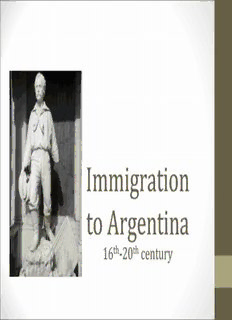
Early Immigration to Argentina - Latin American Network Information PDF
Preview Early Immigration to Argentina - Latin American Network Information
Immigration to Argentina 16th‐20th century Note to Teachers: The information from this PowerPoint primarily comes from my translation of Califa’s comic book, La inmigración en la Argentina: Los que fueron llegando. I found this book at El Ateneo bookstore in Buenos Aires, and I was thrilled to find a resource written at a middle school level. The information presented in the PowerPoint is an overview of Argentina’s immigration history, written with middle school students in mind. Although a PowerPoint was the easiest way for me to present the material to teachers, it is lengthy and may not be suitable for all classes. Feel free to adapt to meet your needs. Starting Point A discussion of immigration to Argentina should begin with an examination of how conquest and colonization affected the land already inhabited by the indigenous people of the region. Indigenous Presence • Argentina was already inhabited by old and developed native tribes when the Spanish arrived. • Towns existed in the Andes, the plains, and the islands. • Some towns were based around agriculture, livestock, hunting, fishing, gathering fruits, etc. Indigenous Presence • Guaranis, located in the north of Mesopotamia and in Paraguay, navigated the Uruguay and Paraná rivers and settled in Río de la Plata. • Mapuches of Chile crossed the neuquina mountain chain in order to form relationships with Pehuenches and Techuelches. First Immigrants • In the 16th century, the first immigrants arrived to Arg entina: the Spanish. • Spanish conquest occurred by different routes – from Peru and Chile and by the Río de la Plata. Spanish Settlements • The Spanish arriving from Peru Present‐day city of Tucumán in founded the first cities of the Tucumán Province North: Santiago del Estero, Tucumán, Jujuy and Salta. • Those from Chile founded Mendoza and San Juan. • Those who arrived by ocean founded Asunción (in Paraguay) and Buenos Aires. Division • Spain had settled several villages by the 17th century. • By this time, the majority of the population was born in America. • There was a clear division between Spanish or “peninsulares” (Iberian from Spain) and “criollos” or Creoles (Spanish‐speaking Americans). Spanish Influence • The Laws of the West Indies prevented Europeans, other than Spanish, from entering America. • These laws did not allow entrance to Spanish Moors and Spanish Jews. • Men from Spain held most of the positions of power in Argentina. • 1776: Spain created the Viceroyalty of Río de la Plata. Río de la Plata Map of the Río de la Plata • El Río de la Plata was an entry port for people and goods. • The Spanish Crown allowed some foreigners like the English, Portuguese, Italian, and French to trade and settle in Buenos Aires. View of Buenos Aires from the Río de la Plata, c.1880
Description: